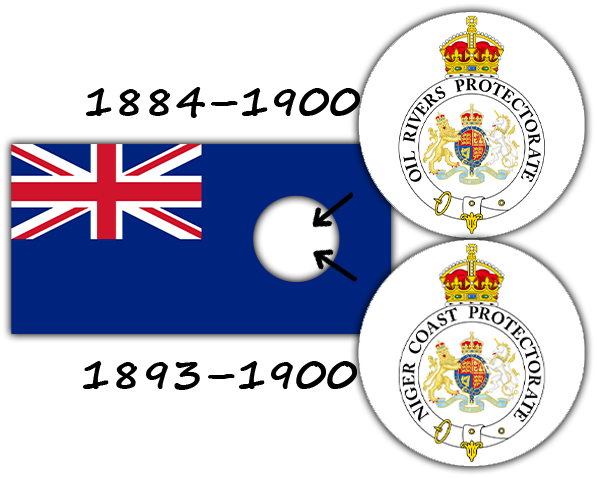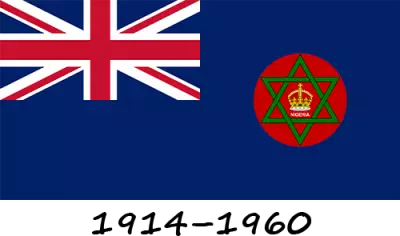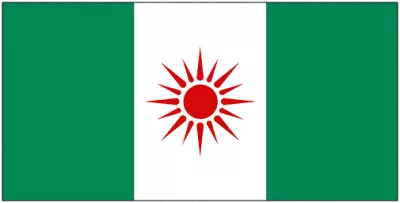The territory of modern Nigeria was discovered by Europeans in the XV century thanks to Portuguese expeditions exploring new trade routes and natural resources. One of the first European navigators to visit the region was João de Sequeira, who landed on the coast of the Gulf of Guinea in 1472. The Portuguese established trade relations with local communities, trading gold, ivory, and pepper, and later began to engage in the slave trade. These territories became important for the transatlantic slave trade, as they allowed crossing the Gulf of Guinea. As interest in the region grew, British sailors and traders began to explore it in the 18th and 19th centuries and, following the Portuguese, sought to control it, so starting in the 19th century, Britain colonized Nigeria.
In 1870, a flag was created for the British-controlled territories in West Africa to represent British West Africa. It was a typical blue flag with a Union Jack, the so-called “Blue Ensign”, with an emblem on the right side: an elephant, a palm tree, a sandy beach and green mountains. These symbols reflected the natural resources and flora of the territory. The elephant symbolized the richness of the fauna, in particular ivory, which was an important export commodity at the time, and the palm tree represented an equally important economic product of trade - palm oil. At the time, it was used as a lubricant for machinery and in the production of soap during the Industrial Revolution in Britain.

The Lagos colony, which existed from 1861 to 1906, used a flag similar to the flag of West Africa. It was the same British blue flag with an emblem that included an elephant, a palm tree, mountains, and an inscription. The main difference was in the text on the emblem: instead of the inscription “West Africa Settlements ‘ on the flag of West Africa, the flag of Lagos had the inscription ’L.”, which meant the colony of Lagos. The British were interested in this region as a strategic trade center through which a significant part of international trade passed, so in 1861 Lagos became a British colony after signing a treaty with the local ruler.
In 1884, Britain officially declared sovereignty over the territory, which was named the Oil Rivers Protectorate. This renaming emphasized the importance of palm oil in the region. The administrative center was located in Calabar, and the territory was administered by a British commissioner. This protectorate operated in parallel with the territory controlled by the Royal Niger Company, which was strategically important for containing German influence in the region.

In 1893, the Oil Rivers Protectorate was reorganized into the Niger Coast Protectorate. This was part of a gradual process of centralization of British administration in Nigeria. The territorial changes and reorganization marked an increase in control over strategically important river routes and trade routes in the Niger Delta. As in the case of British West Africa and the Lagos colony, the Oil Rivers Protectorate and the Niger Coast Protectorate had the same coat of arms and differed only in the inscription around it:
- The centerpiece was the coat of arms of Great Britain, consisting of a lion and a unicorn, which symbolized power and sovereignty;
- The royal crown above the coat of arms indicated the supremacy of the British crown over these territories;
- The inscription on the emblem frame reads: “Oil Rivers Protectorate” or “Niger Coast Protectorate”, depending on the period.
Between 1900 and 1914, the territory of modern Nigeria was divided into two protectorates: Northern Nigeria and Southern Nigeria, each with a separate administrative status and flag:
- In Northern Nigeria, the administration focused on establishing British rule through the Islamic emirates, using a system of indirect rule. This allowed for the preservation of existing power structures, such as the emirs, which became part of the colonial administration;
- In Southern Nigeria, the British encountered more resistance and were more active in implementing their administration. The focus was on trade, particularly the export of palm oil and other raw materials.
The North, with its Muslim emirates, had a more centralized system of government through Islamic leadership, while the South was made up of ethnically diverse peoples with less formalized authorities.
The flags of Northern and Southern Nigeria, like those of the previous period, consist of the coat of arms of Great Britain, the royal crown and an inscription in a circle:
- Northern Nigeria: The standard British Blue Ensign with the emblem in a red circle and the inscription “Northern Nigeria”;
- Southern Nigeria: Similar to the northern protectorate, but with the emblem on a green background and the inscription “Southern Nigeria”.

In 1914, Governor Frederick Lugard merged two separate administrative units, the Protectorate of Northern Nigeria and the Protectorate of Southern Nigeria. This was done to simplify governance and reduce administrative costs. The newly created colony was governed by the principle of indirect rule, when local traditional leaders remained in office, but actual power was concentrated in the hands of British officials. The country's economy at that time was developing primarily in the interests of the British metropolis. The development of infrastructure, including railroads, ports, and transportation routes, facilitated the export of resources such as palm oil, cocoa, rubber, and tin. In parallel with the development of industry, social tensions grew as the local population was drawn into low-paid labor, often in harsh conditions.
Tensions gradually increased, and in the 1920s the first nationalist movements began to emerge. During the Second World War, when Nigerians fought on the side of Great Britain, the ideas of equality and self-determination began to grow stronger. In the 1950s, the National Council of Nigeria and Cameroon party was formed, seeking independence, and in 1954 Nigeria became a federation.

The flag of the Colony and Protectorate of Nigeria was a British blue ensign with an emblem that included a green six-pointed star, known as the Seal of Solomon, surrounding a Tudor crown on a red disk, and below the crown was the inscription “Nigeria”. The six-pointed star is a religious symbol consisting of two equal triangles superimposed on each other to form a hexagonal shape. This symbol has historically been considered an emblem of wisdom and power, as well as a symbol of divine protection. According to medieval legends, the Seal of Solomon is a hexagonal symbol placed on King Solomon's signet ring, which gave him power over demons and the ability to speak to animals. The use of the six-pointed star on colonial flags, including the flag of Nigeria, has a double meaning: it is associated with the idea of British rule and, at the same time, with the reflection of African traditions and cultural symbols that were part of regional beliefs.
On the eve of Nigeria's declaration of independence on October 1, 1960, the country needed a new symbol that would reflect its sovereignty, ideas of unity, and the richness of its national identity. It was decided to create a national flag that would be different from the colonial symbols. To this end, in 1959, the government announced an open competition to design a new flag, which attracted hundreds of designers from all over Nigeria. Among them was Michael Taiwo Akinwunmi, a 23-year-old student studying in the UK at the time. He proposed three vertical stripes - two green, symbolizing agriculture and natural resources, and one white, representing peace and unity.

Initially, the design included a red sun emblem on the white stripe, but the jury decided that the flag would look more harmonious without this element. As a result, the final design consisted of only three equal vertical stripes: green, white, and green. During the declaration of independence, the new flag was solemnly raised to replace the British colonial flag.









